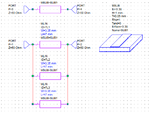Eres_89
Member level 1
Hi All,
in last time, I'm confused due to some simulations in the AWR Environment. I've connected three TLs as a parrarel configuration, and I measured the total impedance of such circuit. According to circuit theory, and my knowledge - I should obserce impedance equal to Z0=Z_TL/3 - so in case presented bellow - it should be Z0 = 2.481 ohms. Unfortunatelly, AWR is showing Z0=0.8428ohm... Proper value can be observed only when port impedance is divided by number of TLs (i.e. 3) - so then the port impedance is equal to 16.67 ohms, NOT to 50 ohms.
E.
Why is this hapen ? Must I consider changes of port impedance to measure "real" value of connection in this case ?
Best Regards,
E.
in last time, I'm confused due to some simulations in the AWR Environment. I've connected three TLs as a parrarel configuration, and I measured the total impedance of such circuit. According to circuit theory, and my knowledge - I should obserce impedance equal to Z0=Z_TL/3 - so in case presented bellow - it should be Z0 = 2.481 ohms. Unfortunatelly, AWR is showing Z0=0.8428ohm... Proper value can be observed only when port impedance is divided by number of TLs (i.e. 3) - so then the port impedance is equal to 16.67 ohms, NOT to 50 ohms.
E.

Why is this hapen ? Must I consider changes of port impedance to measure "real" value of connection in this case ?
Best Regards,
E.
